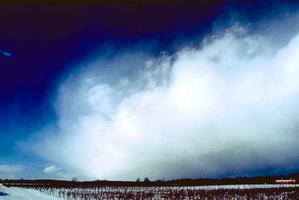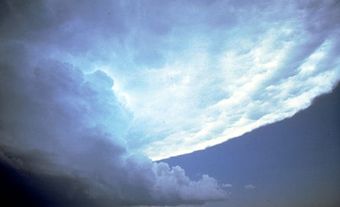Climate is often defined as average weather, when weather means the current state of the atmosphere. For scientists, climates are the result of exchanges of heat and moisture at the Earth's surface. Because of its size, Canada has many different climates. For example, there are drastic differences in day length from south to north: in December, southern Canada receives eight hours of daylight, while northern regions receive none. An area’s position on the continent, especially its distance from oceans, also affects climate. In Canada, this explains why a coastal city in British Columbia, such as Victoria, has a warmer climate than an interior city such as Winnipeg, Manitoba.
Temperature
Temperature is the degree of warmness or coldness. Air temperatures have been measured in some places in southern Canada for over 100 years, but in the Arctic for a much shorter time. Climate statistics are usually expressed as 30-year averages published every 10 years.
In winter, when northern Canada receives very little sun, temperature differences from north to south are great. The mean maximum January temperature of Alert, at the northern tip of Ellesmere Island, is -28.6°C, while in Windsor, ON, it is -0.4°C. That is a difference of 28.2°C. In the summer, the long days in northern Canada result in smaller north-south differences, with maximum temperatures in July of 6.1°C for Alert and 29°C for Windsor. That is a difference of 22.9°C.
In addition to monthly temperatures, climatologists also like to know the total amount of heat received by any given place. To express this total, climatologists have formulated an index of potential evapotranspiration (PE), derived from monthly temperatures above 0°C. Potential evapotranspiration is the amount of water that potentially would evaporate and transpire from a vegetated surface. Therefore, PE is an index of heat. The high arctic islands, for example, receive very little heat and have a PE of 200 mm. In comparison, the warmest areas in southern Ontario, Québec and British Columbia have a PE approximately three times as high. Still, Canada’s maximum PE is but a fraction of that of tropical countries, where the PE exceeds 1,500 mm.
It is also important to note how cold a place can get, especially when considering the cost of heating homes. A parameter that summarizes coldness is the heating degree day (HDD). It is a calculation based on how far below 18°C (65°F) a day’s average temperature is, 18°C being the reference temperature below which heaters are typically turned on. Southern Ontario has 4,000 HDD annually, while the high arctic islands have 12,000 HDD.
Moisture
The most important climatic parameter after temperature is precipitation. Precipitation is moisture that falls to the Earth's surface in such forms as rain, snow, hail. Because of Canada's size, there are great differences in the amount of precipitation received. Since warm air can hold a great deal more moisture than cold air, southern Canada receives more precipitation than northern parts. Because winds usually blow from west to east, the West Coast receives the most precipitation. There are other factors affecting regional precipitation, like the mountains in western Canada and the Great Lakes in central Canada.
Usually, measurements of average annual precipitation are made where people live. Given that most Canadians live in the country’s south, that is where precipitation maps are most accurate. Precipitation can be mapped for a region using lines of equal precipitation called isohyets. Isohyets are generalized in mountainous regions and refer to valley conditions, meaning precipitation totals at higher altitudes are not well known. Annual precipitation ranges from 100 mm in the High Arctic to over 1,500 mm on the windward side of British Columbia's mountains.
Much of the precipitation that falls in Canada evaporates again into the atmosphere (evapotranspiration). The water that does not evaporate runs off into rivers and lakes, and eventually to the ocean. Canada's interior has little or no runoff. Eastern and western areas have large amounts of runoff: these are the areas with major hydroelectric developments.
Climatic Regions
Defining climatic regions for any country is difficult. Climatologists use various climatic parameters, like temperature and precipitation, but it is ultimately the vegetation that serves as an index of a region’s climate type.
Climate types are the net result between moisture gained and lost. This is calculated using the monthly PE and precipitation. This water balance can be graphed. In the settled parts of Canada, water need is usually zero during the winter months, since there is reduced heat and increased precipitation as snow. In July, though, the water need rises to an average of 130 mm, as temperatures soar and precipitation drops. Only Pacific Coast regions have temperatures high enough to cause a need for water in every month of the year. Monthly precipitation varies widely throughout Canada, and nowhere does it coincide with monthly PE. Most localities receive too much moisture in the winter, when the PE is zero, and too little in summer, when maximum need occurs.
The vast, mostly uninhabited Canadian north contains several different climatic regions that can generally be divided into Arctic and Subarctic. In the southern, more populated area of Canada, there are five main climatic regions, each transitioning into the other: the East Coast, Great Lakes, Prairie, Cordilleran and West Coast.
The weather stations described below are examples of the above regions, with the exception of the Cordilleran, which cannot be exemplified by a single station. This region, which includes the Rocky Mountains, is a composite of many climatic types. The southern British Columbia valleys have climates that are the driest in Canada, while some of the higher elevations, especially in the Yukon, have permanent ice caps.
East Coast
East coast climates are represented by Halifax, NS. Precipitation is fairly uniform throughout the year and only in July does water need exceed supply. The vegetation does not suffer immediately since a moisture reserve is stored in the soil (see groundwater). For most soils, the reserve is approximately 100 mm.
In Halifax, this reserve is not exhausted before precipitation rises above need and the stored moisture is again built up to its maximum. Thus, for Halifax, the actual amount of water loss is almost equal to the potential water loss. After soil moisture has reached its maximum, surface or subsurface runoff occurs. In Halifax, total annual runoff is 773 mm.
Great Lakes
Southern Ontario climates are typified by Windsor. Precipitation is rather uniform throughout the year (although less so than in Halifax), but Windsor's summer PE is greater than that of the East Coast, reflecting the higher summer temperatures in the interior of the country.
In May, PE rises above precipitation. By mid-July, in an average year, the stored soil moisture is exhausted. From then on, the vegetation depends solely on current precipitation, until there is enough to build up a soil reserve. In an average year, Windsor is short 86 mm of precipitation relative to its needs.
Prairie
Edmonton is a city typical of a Prairie climate. The annual precipitation of 447 mm is less than the PE of 555 mm, and summer deficits of approximately 120 mm are common. With low winter precipitation, soil moisture is not always restored to capacity in a typical year and water surplus averages only 7 mm (see drought).
Subarctic and Arctic
In Inuvik, north of the Arctic Circle, the monthly PE and precipitation resemble those of stations in the Prairies, but the growing season is shorter. Thus, there is a small amount of runoff as well as a deficiency of 100 mm. Alert, in the High Arctic, has a more severe arctic climate, with a growing season of one month and low precipitation. It also experiences water deficiency, but has an annual runoff of 76 mm.
West Coast
West coast climates are characterized by precipitation that reaches its maximum in the winter and its minimum in the summer. Victoria is a typical station. Mean monthly temperatures are usually above 0°C and water is needed in every month. In an average winter, 130 mm of rain falls every month and the PE is only 14 mm, creating large amounts of runoff. In summer, precipitation is at a minimum when need is at a maximum, causing large water deficiencies.
See also Climate Change; Climate Severity; Climatology; Ice; Meteorology; Urban Effect on Climate; Weather Forecasting.

 Share on Facebook
Share on Facebook Share on X
Share on X Share by Email
Share by Email Share on Google Classroom
Share on Google Classroom






